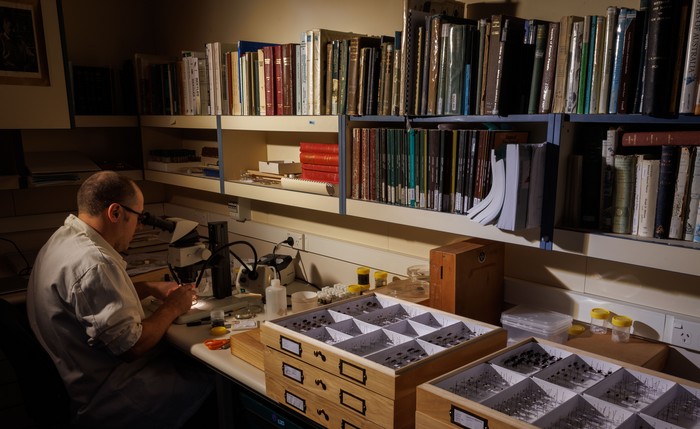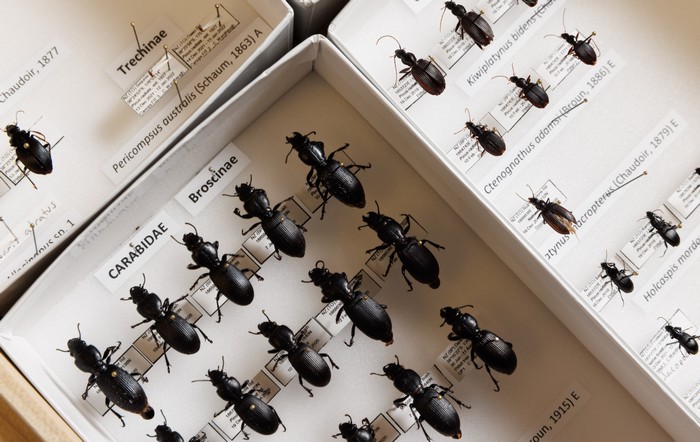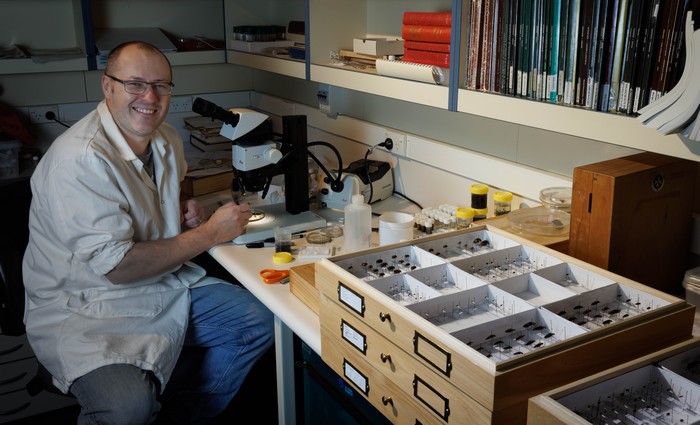Rare beetles and promising finds
Almost 10,000 beetles were collected in efforts to find out how forest harvesting may affect biodiversity, and the results may be surprising.
Harvesting a pine plantation significantly disturbs the ecosystem within it. But promising Scion research shows insect communities could recover when new stands are planted.

Scion entomologist Carl Wardhaugh recently researched biodiversity in Kinleith Forest by looking at beetle species collected from second and third rotation pine stands and native forest remnants. Beetles were chosen due to their high species richness and varied ecology.
Between December 2019 and March 2020 almost 10,000 beetles from 555 species were collected from traps at 15 sites in Kinleith Forest.
The sites included five each of second rotation pine, third rotation pine, and native forest remnants. At each site, three flight intercept traps were placed in the forest canopy, three were placed at ground-level, and three pitfall traps were installed to collect crawling species. This allowed for species collection from each vertical stratum in the forest.
The collection data was used to estimate beetle diversity in different forest stands.
“What we expected to see was a decline in insect diversity with an increasing number of rotations. The land’s been under pine for an extra 30 years, there’s been an extra harvesting event which is a major disturbance event, so we expected to see more species dropping out of the system,” Wardhaugh says.
“We actually found the third rotation sites were more diverse than the second rotation.”
The extrapolated data led to estimates there were 666 beetle species to be found in native forest and 561 across the pine plantation sites – 383 species in second rotation and 456 species in third with some repeated species.
It looks very promising that the insect communities recover when you get a new rotation. - Carl Wardhaugh
Pine stands supported only about 30% fewer beetle species than native forest.
Rarely collected beetles were also found including Brounia thoracica which is only known from 12 specimens collected over the last 150 years. The last was collected in 2003 on Great Barrier Island. During the trapping, four were collected from canopy traps.
Very little is known about the beetle so in addition to preserving the specimens in Scion’s insect collection, individuals are being photographed, and one has been sequenced and stored in a -80°C freezer for potential future molecular work.
They collected seven of the rarely collected Rhipistena lugubris, a parasitoid of longhorn beetles and a Taphropiestes watti which lives in bird nests.
“There’s been very little collection of insects in the forest canopy in New Zealand so some of the rarely collected things we caught in canopy traps are likely to be canopy specialists,” Wardhaugh says.
Forests are being increasingly portrayed as biodiversity deserts and those of us that work in forestry know that this is just a complete fallacy. - Sally Strang
Beetle reinvasion
The reason for increased biodiversity of third rotation stands is unclear but could be anything from site characteristics to accumulation of resources over time, he says.
All the stands were the same age, harvested around the same time, well distributed, and proximity to native forest didn’t appear to be a factor.
Compartment size and a mosaic of different age stands also affect biodiversity.
“It looks very promising that the insect communities recover when you get a new rotation,” Wardhaugh says.

“I think what’s happening is most of the beetles we collected from our sites have reinvaded from adjacent pine sites ... When you’ve got this big mosaic across the landscape of different age stands, all those mature stands end up becoming their own refuge and that’s where those insects radiate out from.”
Wardhaugh says most native species are forest-adapted and pine stands become a valuable environment after canopy closure.
“What most native species really want is a shady, humid, damp, cool environment.
“Pine provides the kind of conditions they quite like, particularly when you get the development of a native understory.”
Wardhaugh says the work helped show pine plantations were more than a “big green desert”.
At least 80% of the beetle species in both pine and native forests were endemic and there was no difference in the proportion of native versus exotic species across forest types.
About 10 to 15% of the collected species could not be identified as definitely exotic or endemic but Wardhaugh says the unidentified specimens are likely to be native because, in general, introduced species tend to be more well-known and therefore easier to identify.
These insects will reinvade and we’re not seeing any evidence of species dropping out of these systems because of harvesting events. - Card Wardhaugh
Future research
Wardhaugh is writing the information into a paper but discussed the findings at the Environmental Forestry Conference earlier this year.
He hopes to seek external funding to look at how biodiversity varies across the country.
He says to make more solid findings, assessments would need to take place in forests nationwide.
“What we really need is a large foundational piece of research to assess the biodiversity value of plantation forests in New Zealand.”
Manulife Forest Management (NZ) environment manager Sally Strang, who chairs the Forest Owners Association’s Environment Committee, says they were blown away by the findings including the number of beetles present, range of species and high prevalence of indigenous species.
“Forests are being increasingly portrayed as biodiversity deserts and those of us that work in forestry know this is just a complete fallacy.

“A number of past studies have focused on threatened species that utilise the forest such as kiwi and bats, which rely on the presence of invertebrates as a food source … Carl’s work has really emphasised why the insect feeders are doing so well out there in our forests, including second and third rotation forests.”
She says finding rarely found species was a bonus.
“It is vital that we continue to support biodiversity studies in our forests to better understand the role that working plantation forests can provide to preserve some of New Zealand’s unique biodiversity and the true biodiversity benefits of our forests as compared to other land uses.”
